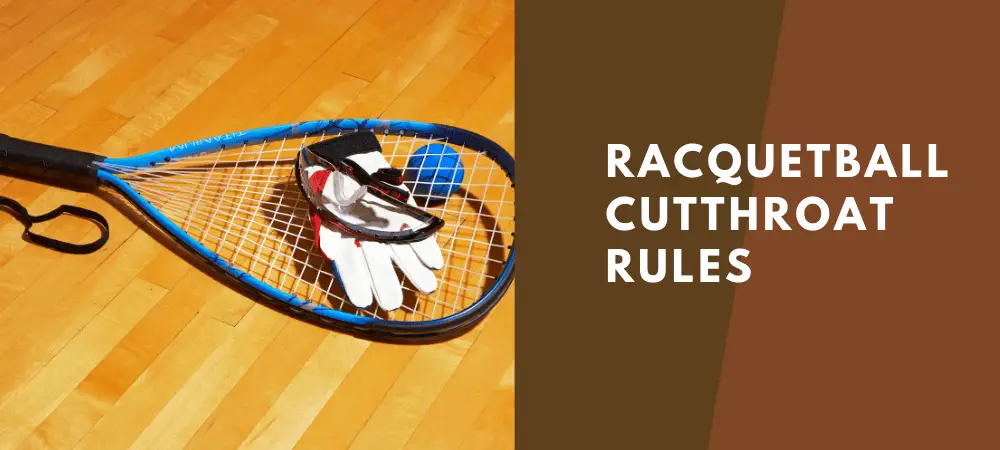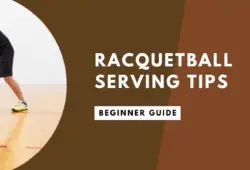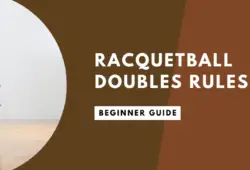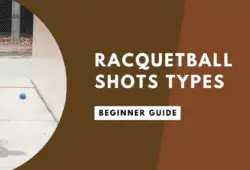There are three players in a Cutthroat Racquetball match instead of only 2 players as in racquetball singles or 4 players in doubles game.
In cutthroat racquetball one server is pitted against two returners. Cutthroat Racquetball is played mostly at the club levels. There are no official rules from the National Masters Racquetball Association (NMRA) for the game since it is not yet featured at the tournament levels.
However, the common basic rules are prevalent in the clubs and schools. So, will go through them in this post. Below you’ll find the basic rules of how to play racquetball cutthroat the right way.
Table of Contents
Basic Rules of Cutthroat Racquetball
Court Dimensions: Court dimensions for Cutthroat Racquetball is the same as the singles and doubles. The front wall is the place to hit the first serve. Subsequent shots can be played onto the two side-walls and the ceiling.
First Serve: Player-1 gets to serve first if he wins the toss. The other two players choose who will do first serve if their team wins the toss.
Initial Standing: The server stands within the serving zone while the returning players stand behind him over the receiving line to the left and right. The player on the right receives the first serve and hits the ball onto the front wall. The player on the left gets to hit it before the server gets his turn to hit. The order of hits may vary once the ball comes into play.
| # | Preview | Product | Rating | |
|---|---|---|---|---|
| 1 |
|
Penn Racquetballs (Pack of 12), Blue | Check today's price |
Serving Method: Server has to bounce the ball in front of him and then play the serve hit. If he is doing the drive type serve, he has to stand on the screen line within the service zone. The ball should hit the floor after hitting the front wall behind the short-line and within the receiving line.
If the server performs other types of serves like the lob, half-lob, soft-z, hard-z, or cross-court, the rule doesn’t apply. He can stand within the service zone, as long as he doesn’t hinder the visibility of the ball to the two returners.
Serve Change: Player-1(server) continues to serve, as long as he wins points on his serve. The returner (player-2) on the right gets to serve if the server loses the rally. The other returner (player-3) moves to the right from the left position. Serve change can happen even when the server hits the ball out of court while rallying.
Scoring Rules: there are 3 games in the match with the first two games being for 15 points and the third one for 11 points. The rule for winning the game is similar to the singles and doubles. The first player to reach the 15 points wins the game; the difference could be even one point…
Only the server gets to win a point when he wins the rally. The serve goes to the player on the right if the server loses the rally. No points are awarded to either of the returning players.
Team: General rule of the game says the team is between Player-1 as the first team and player-2 and player-3 as the other team. Points will be shared on the same rule.
However, there is another version when the team composition can change, For example, Player-1 and Player-3 may become a team (temporarily) when player-2 is serving. The combination can change depending on who is serving.
In the second case, the points will be awarded to the individual players. The player who scores 15 points first will be considered a winner.
Want to read classic racquetball serving rules? click here
Cutthroat Racquetball Faults
Wrong-Serve: If the served ball hits the side wall or the ceiling after hitting the front wall before crossing the short-line, it is considered as a fault. The server has to re-serve the ball. The ball hitting the floor before short-line or on the back wall is also considered as wrong-serve.
Hindrance-Fault: there should be no physical or racquet contact between the three players during the game. No player can hold the racquet in such a position that it blocks the other players’ view of the ball.
Side-Out Fault: The ball is stated to be out of the game in case of a side-out. Serve changes from the server to the returner.
| # | Preview | Product | Rating | |
|---|---|---|---|---|
| 1 |
|
HEAD Racquetball Goggles - Impulse Anti Fog & Scratch Resistant Protective Eyewear w/Clip On... | Check today's price |
Screen-Fault: If the served ball comes too close to the returners’ body when he is unable to make room for playing the shot, it is considered to be a screen-fault.
Random-Fault: if the served ball hits the walls and ceiling randomly before crossing the short-line, wherein the visibility is too poor for the returner, it is considered as a fault.
Foot-Fault: If the server moves out of the service zone before the served ball crosses the short-line, it is a fault. In the case of drive-serve, at least one foot of sever should be within the screen-line until the ball crosses the short-line. Otherwise, it is considered to be a fault.
What Now?
Cutthroat Racquetball is a game which can train you on playing the doubles game in an efficient manner. It will also help you develop the skills for speed, accuracy, and agility when you are pitted against two of the strongest opponents.




